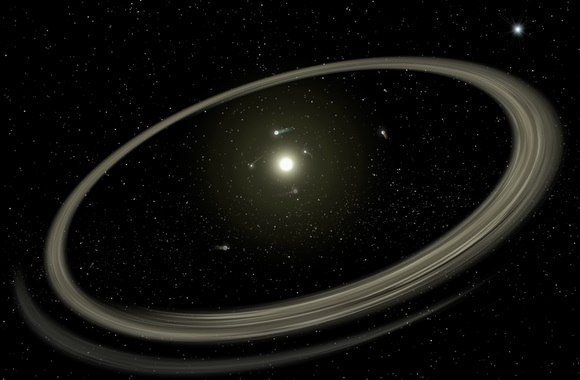[/caption]
A typical model has planets forming from collisions of material swirling around stars. But new laboratory experiments indicate the colliding bodies may be much smaller than most people have thought.
Lead author Oliver Tschauner, of the University of Nevada in Las Vegas, and his colleagues have synthesized a mineral called wadsleyite that naturally exists only in meteorites and deep below the Earth’s crust. It’s believed to be the most abundant mineral in the Earth between the depths of 410 and 520 km (254 to 323 miles).
The conditions where wadsleyite forms are known from long-duration, high-pressure experiments, but the only confirmed natural occurrence is in shocked meteorites, which are remnants of the early solar system. The researchers found small quantities of wadsleyite after a high-pressure laboratory collision between thin layers of magnesium oxide and fused quartz. They suggest the mineral formed in approximately one one-millionth of a second.
On the basis of their experiments, the group inferred that the wadsleyite in ancient meteorites could be generated by collisions between bodies one to five meters (three to 16 feet) in diameter, rather than one to five kilometers (.6 to three miles).
“Based on the present results we suggest that the interpretation of the high-grade shock-metamorphic record in meteorites needs a re-evaluation,” the authors write.
Source: PNAS


Did we really think that there were just ‘big’ pieces of matter drifting about in space? Smacking together and growing as gravity got a foothold?
Seems to me it all traces back to small pieces coalescing into larger pieces, so on and so forth. At some point, everything was minute in size, relatively speaking of course.
When I hear planet formation I think Alan Boss.
Many times common sense gets left out of scientific theories since they are only properly crafted using what is proven from existing evidence. Of course it makes sense that planets should be able to form from truck sized bodies or city sized bodies, but there was never evidence until now to support it. What this finding does indicate is that planets can form more easily ie with less material available than previously thought and more quickly.
This observation is hopefully NOT related to the “Cash for Clunkers” program here in the US 🙂